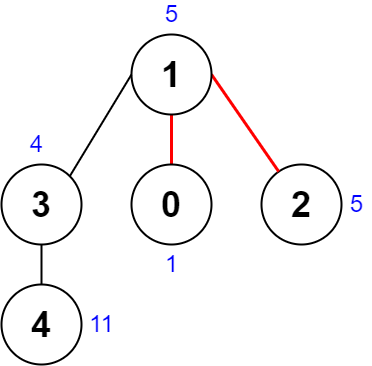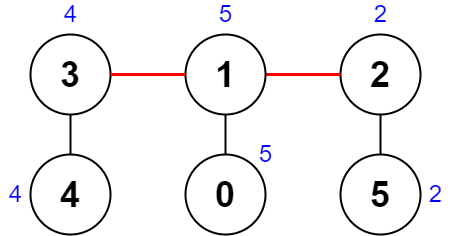- {x}
- The First Day of the Maximum Recorded Degree in Each City
- Count Asterisks
- Count Unreachable Pairs of Nodes in an Undirected Graph
- Maximum XOR After Operations
- Number of Distinct Roll Sequences
- Check if Matrix Is X-Matrix
- Count Number of Ways to Place Houses
- Maximum Score Of Spliced Array
- Minimum Score After Removals on a Tree
- Find Minimum Time to Finish All Jobs II
- Product Sales Analysis IV
- Decode the Message
- Spiral Matrix IV
- Number of People Aware of a Secret
- Number of Increasing Paths in a Grid
- Product Sales Analysis V
- Valid Palindrome IV
- Read More...

Minimum Score After Removals on a Tree
There is an undirected connected tree with n nodes labeled from 0 to n - 1 and n - 1 edges.
You are given a 0-indexed integer array nums of length n where nums[i] represents the value of the ith node. You are also given a 2D integer array edges of length n - 1 where edges[i] = [ai, bi] indicates that there is an edge between nodes ai and bi in the tree.
Remove two distinct edges of the tree to form three connected components. For a pair of removed edges, the following steps are defined:
- Get the XOR of all the values of the nodes for each of the three components respectively.
- The difference between the largest XOR value and the smallest XOR value is the score of the pair.
- For example, say the three components have the node values:
[4,5,7],[1,9], and[3,3,3]. The three XOR values are4 ^ 5 ^ 7 = 6,1 ^ 9 = 8, and3 ^ 3 ^ 3 = 3. The largest XOR value is8and the smallest XOR value is3. The score is then8 - 3 = 5.
Return the minimum score of any possible pair of edge removals on the given tree.
Example 1:

Input: nums = [1,5,5,4,11], edges = [[0,1],[1,2],[1,3],[3,4]] Output: 9 Explanation: The diagram above shows a way to make a pair of removals. - The 1st component has nodes [1,3,4] with values [5,4,11]. Its XOR value is 5 ^ 4 ^ 11 = 10. - The 2nd component has node [0] with value [1]. Its XOR value is 1 = 1. - The 3rd component has node [2] with value [5]. Its XOR value is 5 = 5. The score is the difference between the largest and smallest XOR value which is 10 - 1 = 9. It can be shown that no other pair of removals will obtain a smaller score than 9.
Example 2:

Input: nums = [5,5,2,4,4,2], edges = [[0,1],[1,2],[5,2],[4,3],[1,3]] Output: 0 Explanation: The diagram above shows a way to make a pair of removals. - The 1st component has nodes [3,4] with values [4,4]. Its XOR value is 4 ^ 4 = 0. - The 2nd component has nodes [1,0] with values [5,5]. Its XOR value is 5 ^ 5 = 0. - The 3rd component has nodes [2,5] with values [2,2]. Its XOR value is 2 ^ 2 = 0. The score is the difference between the largest and smallest XOR value which is 0 - 0 = 0. We cannot obtain a smaller score than 0.
Constraints:
n == nums.length3 <= n <= 10001 <= nums[i] <= 108edges.length == n - 1edges[i].length == 20 <= ai, bi < nai != biedgesrepresents a valid tree.
Minimum Score After Removals on a Tree
This problem involves finding the minimum score achievable by removing two edges from a tree, resulting in three connected components. The score is calculated as the difference between the largest and smallest XOR sums of the values in each component.
Approach
The solution uses Depth-First Search (DFS) to efficiently calculate XOR sums of components. The overall strategy is as follows:
-
Preprocessing: Build an adjacency list representation of the tree from the given
edges. Calculate the XOR sum (s) of all node values in the tree. -
Iterate through Edge Pairs: The algorithm iterates through all possible pairs of edges to remove. For each pair:
-
DFS to Calculate XOR Sums: After removing a pair of edges, we are left with three connected components. Two nested DFS functions are used:
dfs(i, fa, x): Calculates the XOR sum of a subtree rooted at nodei, excluding the subtree rooted at nodexand avoiding cycles by tracking the parent nodefa. This is crucial to isolating the components.dfs2(i, fa, x): This DFS function recursively explores the tree, calculating the XOR sum of the current component and updates the minimum score (ans).
-
Calculate and Update Score: For each component, the XOR sum is computed using
dfs. The difference between the largest and smallest XOR sums among the three components is the score for the current edge pair. The minimum score found so far is updated. -
Return Minimum Score: After exploring all edge pairs, the function returns the minimum score found.
Time Complexity Analysis
- Building the adjacency list takes O(E), where E is the number of edges (E = N-1 for a tree).
- Iterating through edge pairs takes O(E^2) = O(N^2) time.
- Each DFS call takes O(N) in the worst case.
- Therefore, the overall time complexity is dominated by the nested loops and DFS calls, resulting in O(N^3).
Space Complexity Analysis
- The adjacency list uses O(E) = O(N) space.
- The recursive DFS calls use space proportional to the recursion depth, which is O(N) in the worst case (a completely skewed tree).
- Therefore, the overall space complexity is O(N).
Code Explanation (Python)
class Solution:
def minimumScore(self, nums: List[int], edges: List[List[int]]) -> int:
def dfs(i, fa, x): #DFS to calculate XOR sum of a component
res = nums[i]
for j in g[i]:
if j != fa and j != x:
res ^= dfs(j, i, x)
return res
def dfs2(i, fa, x): #Recursive DFS to explore components and update min score
nonlocal s, s1, ans
res = nums[i]
for j in g[i]:
if j != fa and j != x:
a = dfs2(j, i, x)
res ^= a
b = s1 ^ a
c = s ^ s1
t = max(a, b, c) - min(a, b, c)
ans = min(ans, t)
return res
g = defaultdict(list) #Adjacency list
for a, b in edges:
g[a].append(b)
g[b].append(a)
s = 0 #XOR sum of all nodes
for v in nums:
s ^= v
n = len(nums)
ans = inf #Initialize minimum score to infinity
for i in range(n): #Iterate through edge pairs
for j in g[i]:
s1 = dfs(i, -1, j) #Calculate XOR sum of first component
dfs2(i, -1, j) #Recursive DFS to explore other components and update score
return ansThe code in other languages (Java, C++, Go) follows a similar structure and logic, with appropriate syntax changes for each language. The core algorithms remain the same: building the adjacency list, iterating through edge pairs, performing DFS to compute component XOR sums, and updating the minimum score.